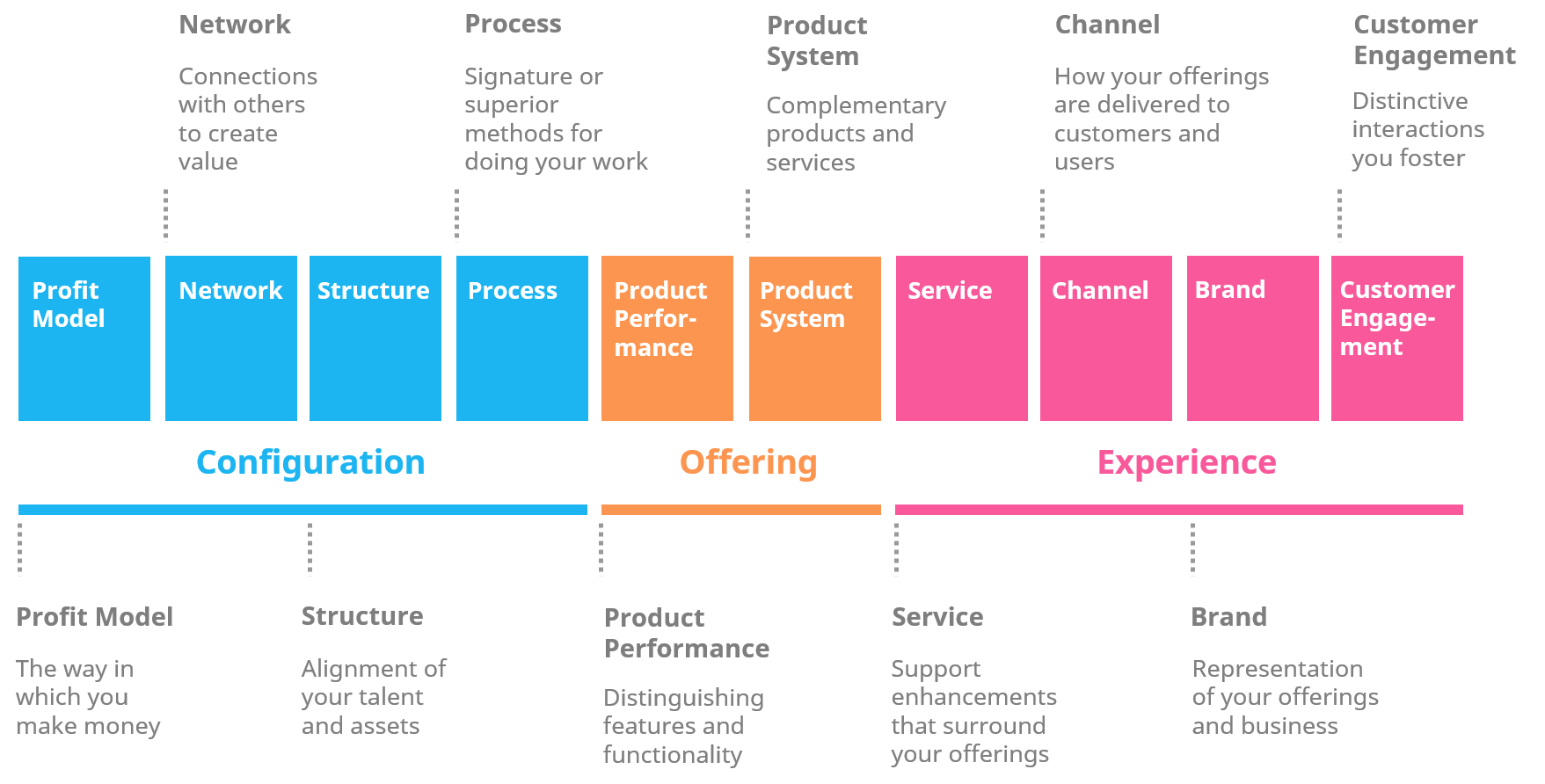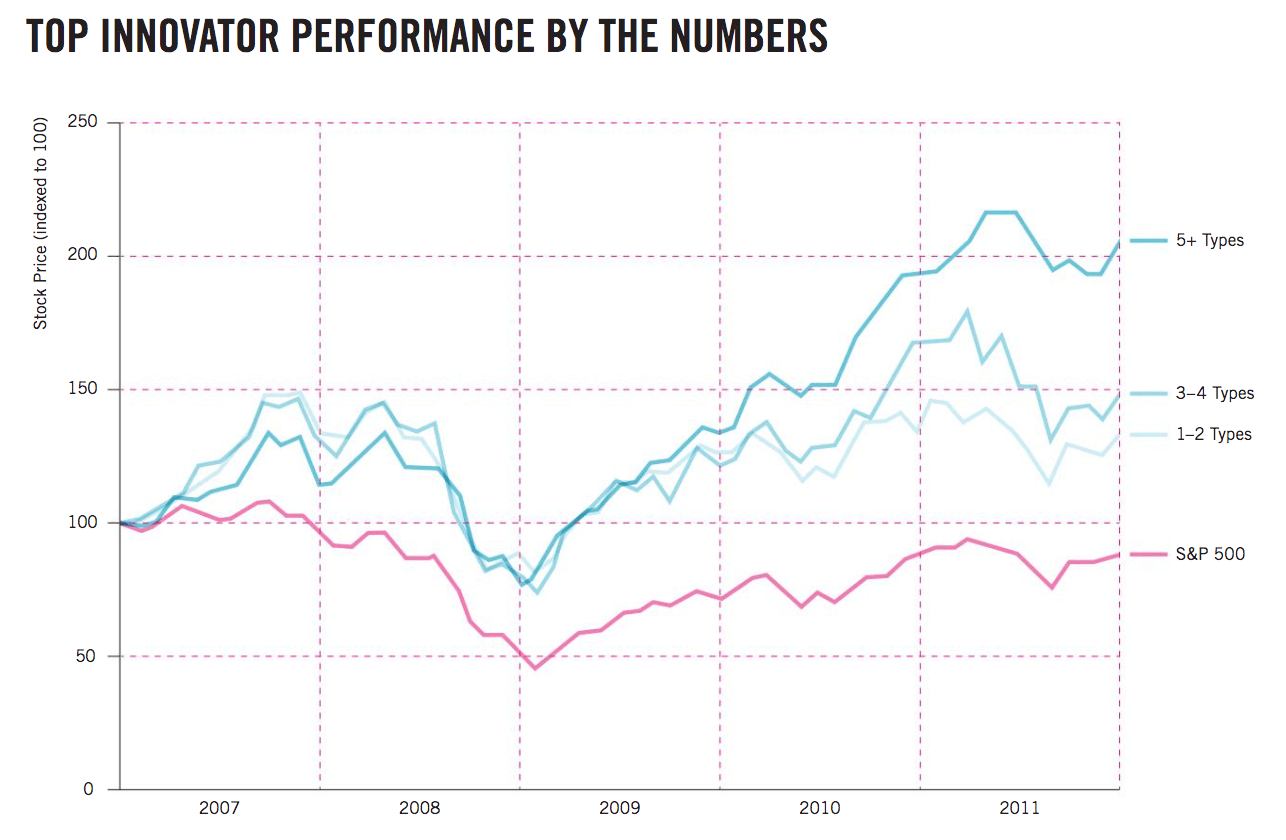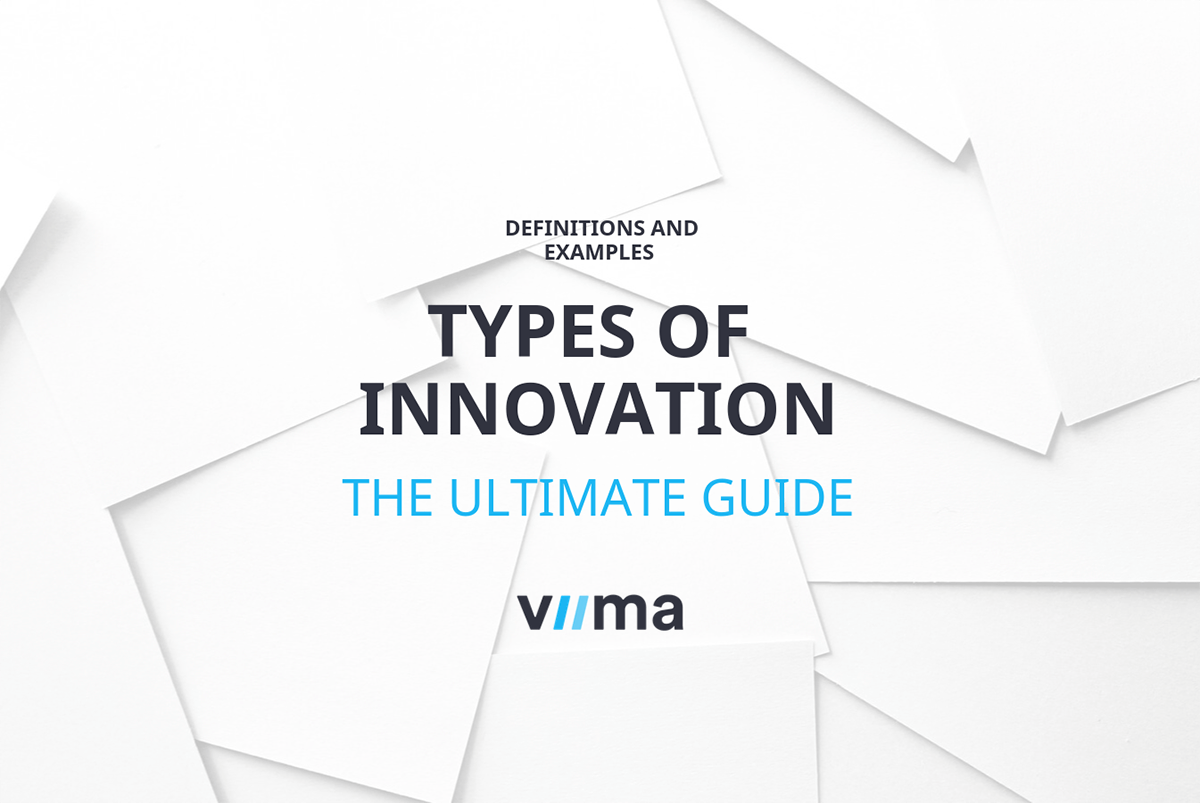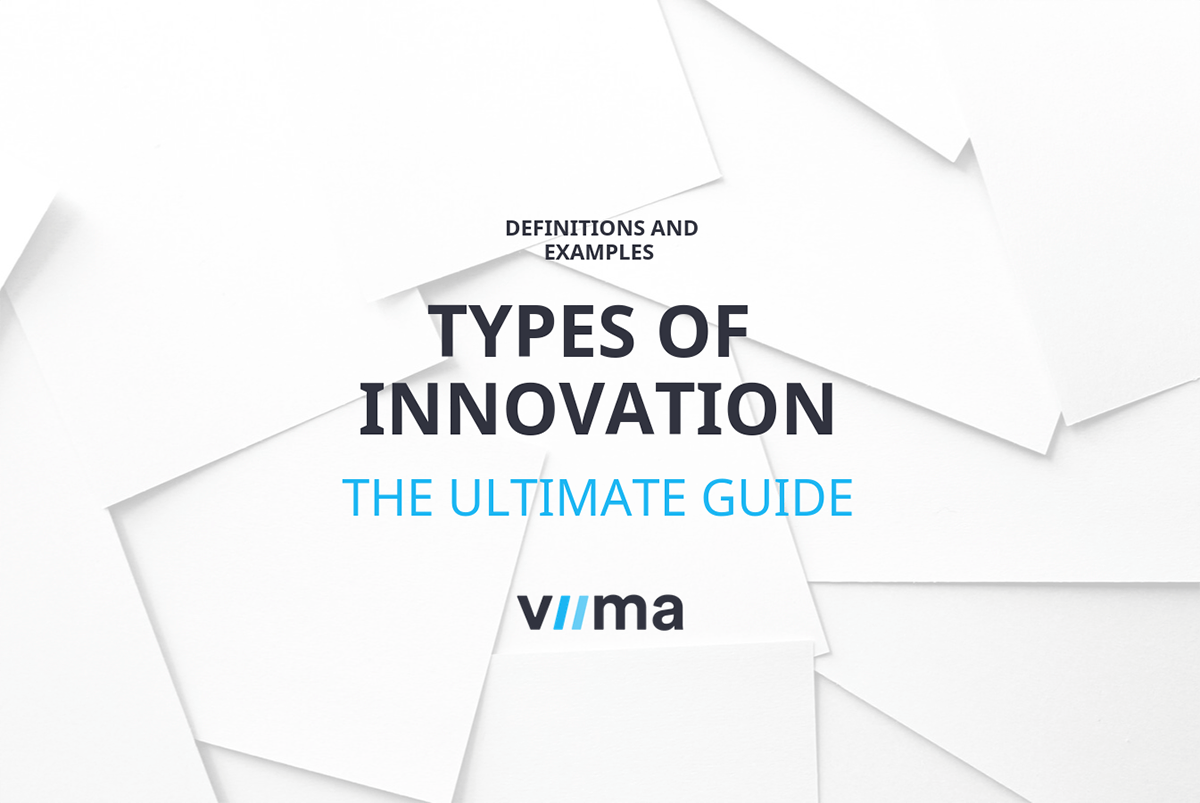The Ten Types of Innovation Framework Explained
When we hear people talk about innovation, we often hear it being used as a synonym for new products, or perhaps new features in existing products.
In reality, that is quite a narrow view of innovation and, in our experience, it is one of the root causes leading to many of the mistakes inexperienced innovators make.
Getting past the implications caused by this can often be challenging, especially in larger organizations where everyone won't be familiar with innovation.
These challenges, however, are not exactly a new thing. Innovation consultancy Doblin actually realized that way back in the 90’s and developed the Ten Types of Innovation Framework to help solve the problem.
It’s a simple, elegant, and practical tool that pretty much every innovator can benefit from, so we’ll explore the topic in more detail in this article.
Table of contents
The Framework Explained
Based on their research of more than 2000 successful past innovations, Doblin realized that not only are there different types of innovations out there, but also that all innovations are actually comprised from the same basic elements. Those ten elements can be further grouped into three main areas that they refer to as the configuration, offering and experience.
Those ten elements can be further grouped into three main areas that they refer to as the configuration, offering and experience.
Starting from the left, configuration essentially covers the internal workings of the organization and its business model etc.
Offering covers the key aspects of the products and/or services the organization offers.
And finally, it ends on the right with the outward facing elements of the business, or in other words, the whole customer experience.
We’ll explore each of these elements in more detail later in the article, but for now, the key is understanding that the most successful innovators take all of these aspects into account.
The Why behind the framework
We’ve written quite extensively about the mechanisms for innovation being so vital for medium to long-term performance, that we won’t repeat these points here.
However, in their book bearing the same name as the framework, Doblin presented a compelling case for the benefits of not just innovation in general, but also for using multiple types of innovations in one’s products or services.
Based on their research, the more different types of innovations an organization used, the better their financial performance clearly was, as illustrated in the chart below.
Source: Ten Types of Innovation: The Discipline of Building Breakthroughs, 2013, Wiley
While there are obviously more factors than just innovation at play here, the outperformance of top innovators is still incredibly large with their stock price more than doubling in just five years when the benchmark actually saw their prices decline during the same period.
How do you use the framework?
Now that we’ve established the importance of using multiple types of innovations, it’s time we look at how to actually use the framework.
The Ten Types framework is actually a very versatile and practical tool that can help you better succeed in innovation in a number of different ways.
In addition to designing new innovations, you can also use it for assessing how innovative an organization and its services and products actually are, or for trying to understand or rethink a given market and identify opportunities for innovation within it.
In essence, to use it, you can simply assess your product, service, or market on each of the ten elements or types in the framework, see where things are already done well, and where there is plenty of room for improvement and innovation.
Once you’ve identified these areas, you can simply start to think of new ways to drive value in each of these areas.
If you’re having a hard time getting started, Doblin has also created a list of roughly 100 different tactics you can use to come up with new innovations in the aforementioned areas.
Now, once you have plenty of ideas on brand new innovations or innovative improvements to your existing products, you probably don’t have the resources and the skills to work on all of them simultaneously. That’s not really much of an issue, it just proves the importance of properly managing and prioritizing those ideas.
What are the Ten Types?
Before we move on to a practical example of using the framework, let’s first go through each of the ten types to see what an innovation is actually comprised of.
Profit model
The first, and quite obvious part of an innovation, is its profit or business model. While non-profits and governmental organizations can certainly innovate without making profits, every innovation still costs something to produce, and it should always generate more value than that for the organization producing it.
Most industries usually have only one primary profit model, which most, if not all, of the key players in the industry have embraced, often for extended periods of time. Challenging this model can be a great way to align your innovation and your incentives better with those of your customers, which will provide you with a clear competitive advantage that is also often difficult for competitors to copy. There are tons of interesting profit models you could consider in addition to the classic “buy upfront” model, such as auctions, risk-sharing, subscriptions, freemium and licensing models, to name just a few.
There are tons of interesting profit models you could consider in addition to the classic “buy upfront” model, such as auctions, risk-sharing, subscriptions, freemium and licensing models, to name just a few.
A great way to find ideas for new profit models is to look at what some of the most innovative and successful companies in other industries are doing.
Networks
The rise of globalization and the Internet have made networks more powerful and easier to form and manage than ever before, which has further highlighted their importance.
Network economy is a term some use to refer to our current, post-industrial age given how virtually all of the most valuable companies in the world derive a large portion of their valuation from the power of their networks.
In essence, network innovations take advantage of other companies’ processes, technologies, products, channels, brands – and naturally those of customers and consumers as well. The right networks and partnerships can be a great way to create a tremendous amount of value quickly while simultaneously building a significant moat towards would-be competitors.
The right networks and partnerships can be a great way to create a tremendous amount of value quickly while simultaneously building a significant moat towards would-be competitors.
In simple cases, this can simply mean the use of an existing infrastructure to get an innovation to market quickly, franchising, vertical supply chain integration, all the way to building social networks and online marketplaces.
Structures
Organizational structures are another great, yet often overlooked, target for innovation. This covers pretty much everything from your organizational design, competencies and assets, incentives and management structures, all the way to knowledge management.
How you align and improve your internal assets and talent, is usually a very strong forward indicator for determining the failure success of a business.
Simply put, organizational structure and incentive systems essentially forms your cost structure, as well as the behavior of employees.
The challenging part here is that there isn’t just a single correct answer, but the right structures depend heavily on the kind of industry you’re in and the business model you have.
To improve this area, you want to make sure that the internal communication isn’t blocked at any point and that your employees have the right tools for making their ideas heard, developed and put in practice. Here, a dedicated tool for innovation management can help.
Processes
Internal processes are what an organization uses to develop and deliver their products and services.
As processes are often very similar in most organizations in any given industry, most people don’t pay much attention to them. They’re also not as prominent as the products and services or the customer experience, but they’re arguably even more important in the long run.
Innovations in internal processes can obviously create tremendous improvements in costs, but also in the organization’s ability to create new, even better products and services, as well as grow and scale effectively.
What’s more, as these innovations are not as obvious to your competitors either, they are often also challenging for competitors to identify and copy, which can prove another clear source of competitive advantage.
Opportunities for incremental process improvements are often easy to identify and implement, but internal processes obviously benefit from bigger and more dramatic innovations too.
If you’re having a hard time identifying such opportunities, it’s often a good idea to observe what innovative companies in other industries are doing, just like it was the case with profit models. Some examples of potential areas to pursue are lean methodology, predictive analytics, process automation, standardization, user involvement and even crowdsourcing.
Product performance
Moving on to the actual product or service, performance is an obvious area of innovation for every organization. It is what most people actually mean when they talk about innovation.
This essentially means improving the products ability to create value. In other words, improving things such as the quality, price, safety, ease-of-use or sustainability of the product or service, but also the creation of new features.
It probably goes without saying, but top innovators always keep improving the performance and design of their products, no matter how great they already are.
Product system
These days, fully stand-alone products and services are actually not very common. A significant portion of all products and services are used together with other complementary ones.
For example, enterprise software has to work seamlessly together with all of the other software being used at the organization, and your phone has dozens of apps from different companies, and you’re probably using it together with headphones, your car, and many other devices and services.
Product system innovation refer to improvement and changes you do to ensure that your products work together with other complementary ones in a way that creates more value than the product alone could. In practice, that can mean a wide range of things, such as bundling your own products and services together, creating extensions, plug-ins and integrations with other products, making your offering modular, or even creating your own platform that third parties can join to strengthen the ecosystem.
In practice, that can mean a wide range of things, such as bundling your own products and services together, creating extensions, plug-ins and integrations with other products, making your offering modular, or even creating your own platform that third parties can join to strengthen the ecosystem.
Service
Service innovations ensure and improve the utility and value of a given product or service. Services can make a product easier to try or use or help solve potential challenges throughout the customer journey.
Great service can make customers love even mediocre products, which naturally helps with customer satisfaction and loyalty.
Guarantees, free trials, self-service systems, and supplementary or simply superior service are all examples of things that organizations can try in this area.
While most organizations already understand the importance of good service, most organizations still have plenty of room for innovation on this front.
Channel
A channel is simply a method you use to connect your offerings with your customers and users.
Traditionally that has meant physical channels such as retail stores or wholesale distribution, but e-commerce, direct to customer, and other forms of digital channels have become extremely important in most product categories, even if the product itself is still physical, for marketing, sales, and customer service purposes.
Different channels are relevant for different kinds of product and services, so the key lies in knowing what would make your customer’s lives easier. Thus, innovators should always look for ways to rethink their use of different channels to provide their customers and users as smooth and seamless of a customer experience as possible. Some examples of channel innovations are pop-up stores, on-demand and home delivery, flagship stores, diversification and omni-channel approaches.
Some examples of channel innovations are pop-up stores, on-demand and home delivery, flagship stores, diversification and omni-channel approaches.
Brand
A brand is simply the perceived representation a customer has of the offerings of a given business.
The purpose of brand innovations is thus, in essence, simply to help customers and users recognize, remember, and hopefully prefer a given brand over the competitors.
To reach those goals, a brand should be able to distill the key value promises of a business to craft a clear identity for it. Traditionally that has been considered to be primarily the role of design, communications, and advertising, but there’s also plenty of room for novel ways and innovations.
You could, for example, consider methods such as co-branding to enhance your brand image, get certifications and testimonials to improve credibility, or work on transparency and values to create more trust.
Customer Engagement
Many of the most successful products and services have identified the underlying desires and aspirations of their customers that go beyond the functional needs.
If you are able to connect with your customers in those areas, their experience with your organization will be far more rewarding, joyful, and memorable.
To give you a couple of examples of potential innovations in this area, you could help a customer master a given skill related to using your product, allow them to personalize their experience, or perhaps cater to their desire to belong to a vibrant community of like-minded people.
An example: Tesla
There are very few companies that have been successfully able to innovate in all of the Ten Types, but probably the timeliest of these examples is Tesla.
They obviously operate in the incredible competitive automotive and energy industries with typically thin margins and huge barriers to entry, so just them being able to get to where they are today has exceeded almost everyone’s expectations. And to get there, they’ve had to do quite a lot of different kinds of innovations.
So, let’s look at a few examples of what they’re already done, or are currently working on using the Ten Types framework. If we start with the Configuration part, the biggest thing they’ve focused heavily on rethinking the Networks, Structures and Processes that have traditionally been used in the automotive industry.
If we start with the Configuration part, the biggest thing they’ve focused heavily on rethinking the Networks, Structures and Processes that have traditionally been used in the automotive industry.
They’ve abandoned the dealer network, focused on vertical integration to eliminate complexities and overhead from their supply chain, and done a lot of process innovation in order to get their prices to be comparable with similar internal combustion engine cars, to enable over the air software updates for their vehicles first in the industry, and to help them develop and test their self-driving software as effectively as possible.
In the Profit model section, they pioneered the pre-order model to help fund the development of their upcoming cars and provide shareholders faith in the future of the business. More importantly, electric cars require much less regular maintenance and spare parts, so instead of relying on services to drive incremental profitability, Tesla has focused on software to do this.
When it comes to Offering related factors, Tesla has obviously done hundreds of incremental innovations throughout the years to improve their products beyond the status quo across a wide range of performance metrics, such as price, range, acceleration, safety, and infotainment system functionality. They’ve also provided their customers with products that complement the car well, such as their supercharger network and home solar and energy storage.
Put together all these changes have made the experience of using and owning the product so great that Tesla customers are extremely happy with their vehicles.
In the Experience space, Tesla has again done a number of innovations. They, for example, were the first carmaker that really made it possible to buy a car online, operate their own stores, as well as allow you to return the car if you’re not fully satisfied with it after the first 7 days. They also have a mobile service fleet that can come to fix the car where you are, instead of you having to take it to the nearest service station.
They’ve obviously invested a lot of time and effort into being transparent about their values and mission, which together with their pioneering products, has helped create a very strong brand and community for them, which they've manage to leverage well. As a result, Tesla managed to become simultaneously the fastest growing and most profitable mass market car manufacturer, an unprecedented feat in such a mature and competitive market.
Conclusion
To conclude, innovation is much more than just creating a brand new product, and the best innovators know this very well.
The Ten Types framework is a very practical and useful tool for keeping that in mind, and for thinking about innovation holistically.
As mentioned, it isn’t much of an exaggeration to say that the more different kinds of innovations you’re able to combine, the more successful your product or service is likely to be – as long as those innovations are actually useful.
So, think about your product or service. Which of these areas could you innovate on to make it even better?
If you’d like to understand the different types of innovations even better, you might want to read our guide on the topic.






